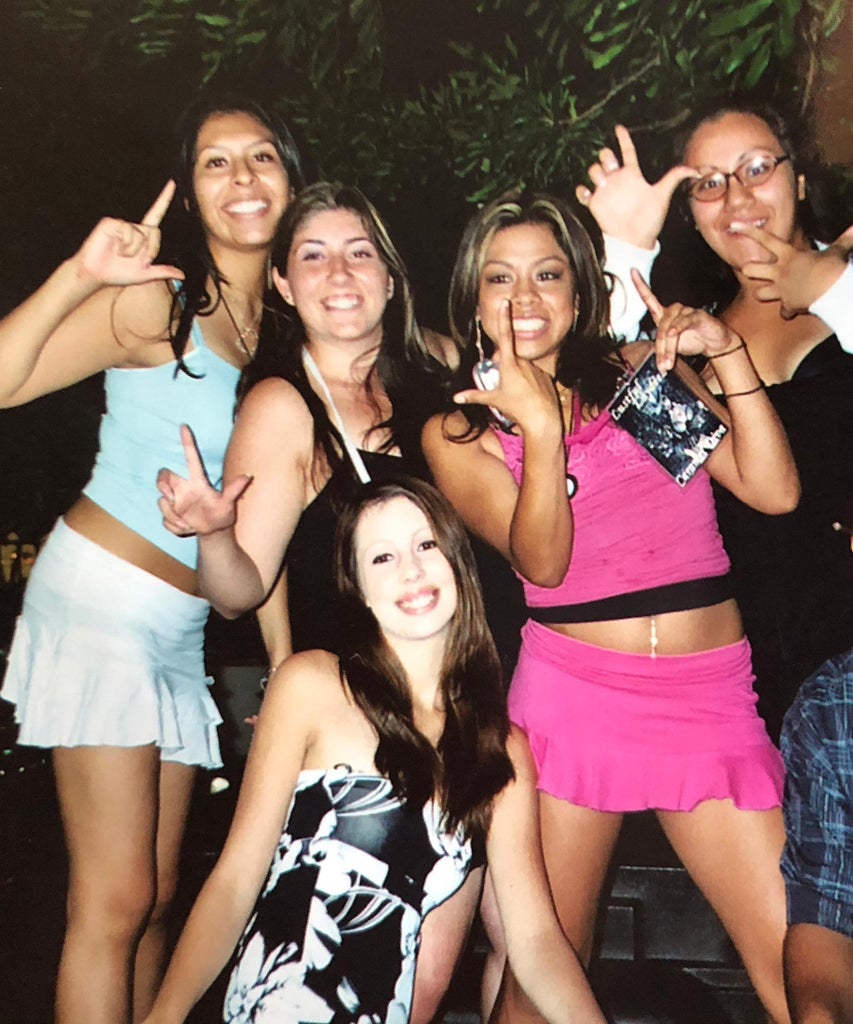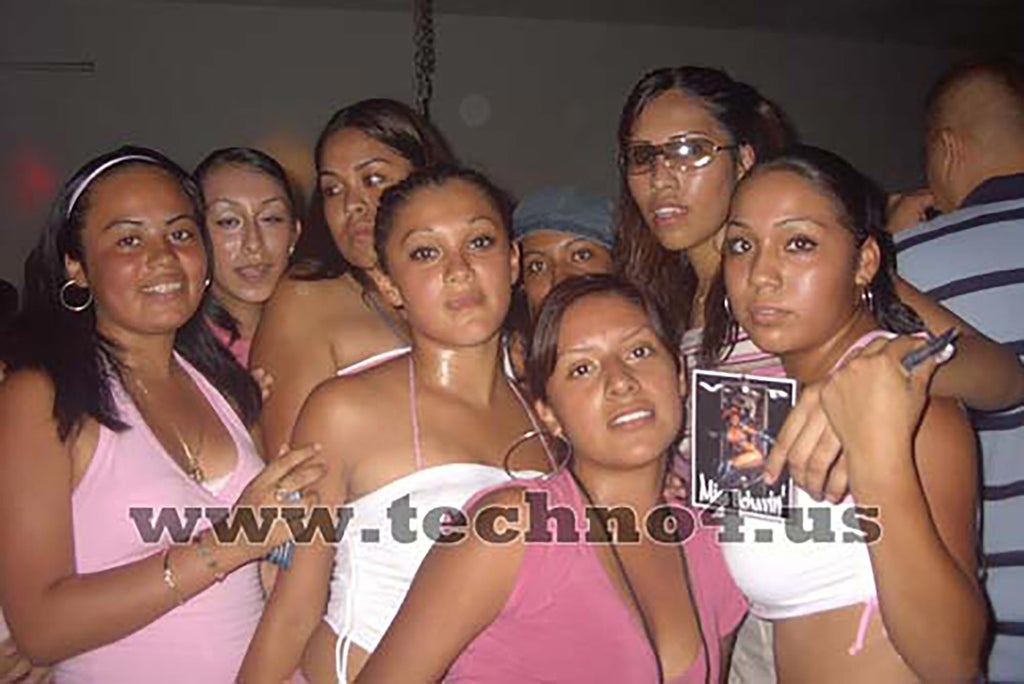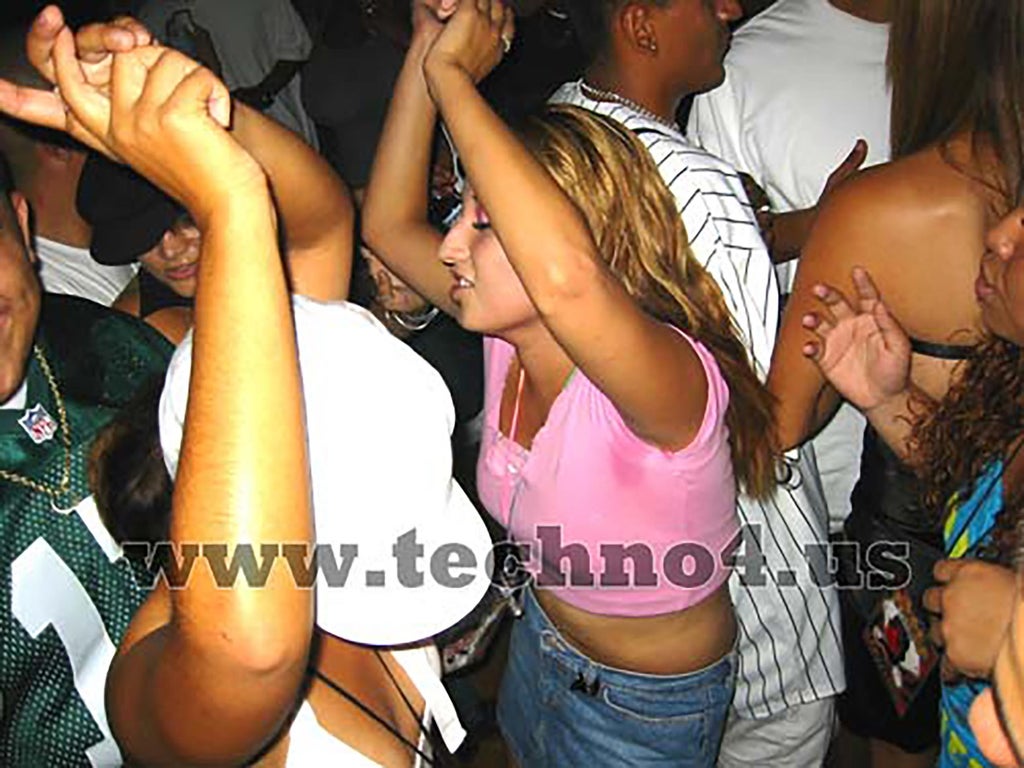
When I close my eyes, I can still feel the dew from the fog machine on my skin and the beat of the music blasting from the giant floor speakers. I can see groups of teenage girls in matching pink tops and hear them chanting their party crew names at the top of their lungs. I see the lights reflecting off the laminated party crew badges hanging around their neck. The dance floor — a slab of concrete in a stranger’s muddy backyard.
The simple definition of a “party crew” is a group of friends (mostly teenagers) who are dedicated to going to and throwing underground parties. Party crews have a history with Latine youth across the country, especially in Los Angeles. Since the 1980s, party crews have been dedicated to throwing wild backyard parties. In the ‘90s, the party crew tradition continued and has been archived and documented by artist Guadalupe Rosales through her social media projects Map Pointz and Veteranas and Rucas. Each era had their own style and their own music, but what has united party crews throughout the decades is the need for community and a space to break free from the pain and pressures of the world around them.
For Latine teens like me in the 2000s, the party crew scene was the place to grind the night away far away from parental supervision. The underground events were called “flier parties” because of the glossy paper fliers that promoted the parties. Every party crew had a name, like Lunatic Ladies, Get Low Productions, and Profile Playaz, to name a few. Kids represented their crews by wearing badges around their necks to display their party crew logos. The parties usually took place in the back of someone’s house or an empty warehouse, and the music of choice was 2000s hip-hop and reggaeton. Imagine the DJ playing “Pa’ Que Retozen” by Tego Calderón into Too $hort’s “Shake That Monkey.” The ass-shaking never stopped — unless, of course, the cops broke up the party or partygoers broke out in a fight. Sometimes, shots were fired. Our safe space wasn’t perfect, but it was ours.
“Our safe space wasn’t perfect, but it was ours.”
Janice Llamoca
I grew up in the San Gabriel Valley, east of Los Angeles, a valley full of immigrants. My parents came from Peru in the mid-’80s escaping social and economic crises. I was born a year into their arrival. Because my mom grew up in the evangelical Christian church, our home life was overall strict and religious. We went to church every Sunday and didn’t celebrate Halloween, meaning I have never trick-or-treated, ever. By the ‘90s, a lot of my family on both my mom’s and dad’s sides had immigrated, so there was a family party almost every weekend. The adults moved naturally to salsa, chicha, cumbia, and merengue rhythms. Their bodies just knew what to do. Everyone danced except my mother, who never learned because of her religious upbringing. She’d always ask me to sit next to her while everyone was up moving their bodies. Soon, I realized I hadn’t learned to dance either. It made me hyper-aware of how my body moved in public.

As a teen girl in the early 2000s, I was shaped by hip-hop music videos of the era. Video vixens were queens. Voluptuous models like Melyssa Ford and Vida Guerra were the director’s muses and completely outshined the rappers. I was mesmerized by their power. But the video that blew me away was Beyoncé’s “Crazy in Love.” I watched it carefully and copied Bey’s every dance move. I even tried to look like her. I bought the white tank top, the blue denim shorts, and the red stiletto slingbacks (or whatever imitation I could find at the swap meet). It gave me a glimpse into what being a young woman could look like. It was sexy, fun, and fashionable; it was rebellious. It was a type of freedom I hadn’t seen in person and so different from the modestly dressed women I grew up with at church.
I knew if a bit of that freedom could rub off on me — I could do anything.
The summer going into my junior year of high school, a couple of my friends and I joined an all-girl party crew. We called ourselves the Lustful Laydeez. On the weekends, my friend Sammy and I would change into our halter tops and short skirts and sneak out of our homes. We’d dance the night away to the musical stylings of the Ying Yang Twins and Daddy Yankee. Somehow, we’d get back in our rooms before our families woke up. I’d always be falling asleep at church the next day.



The flier parties were outside in the dark and everyone was too busy having fun to care that I didn’t actually know how to dance. I felt like there weren’t official steps to grinding, freaking, and perreando, except moving your hips to the beat. It wasn’t the Spanish music I grew up with, but with these genres, I could make dancing my own. When I was out at flier parties dancing, I was discovering how my body could move and seeing how others reacted to me. In some ways, it was the release I was yearning for, one that I couldn’t find at my own family parties.
“When I was out at flier parties dancing, I was discovering how my body could move and seeing how others reacted to me. In some ways, it was the release I was yearning for.”
JANICE LLAMOCA
On the dance floor, my friends and I were discovering how others responded to us. We wanted to be lusted after and desired. We thought: Isn’t that what it means to be a woman? To be in control of our destiny? But on the same dance floor, we were learning that society saw our bodies as dangerous and that being too free with them made us “bad” or undesirable. We were trying to be free in a world where women’s bodies were seen as objects. Guys would grab us while we danced; some would get aggressive and freely call us “sluts” when we chose to ignore them.
What I see when I look back now is a group of teen girls trying to figure out an impossible balance: of being the exact right amount of sexy to be desirable, but not showing “too much” that we lose being worthy of respect.
Twenty years have passed since I’ve found myself on a concrete slab of a dance floor in somebody’s muddy backyard. Looking back, I’m reminded of how important the party crew scene was to how I came of age despite its dangers. It was a space to be free: free from parents, free from judgment, free from expectations, free to move my body, and free to express myself any way I wanted. And when our safe spaces are limited, the scene and its freedom just feel more worth it.
All episodes of Party Crews: The Untold Story are available now, wherever you get your podcasts.
Like what you see? How about some more R29 goodness, right here?
from Refinery29 https://ift.tt/l5FobxN
via IFTTT
